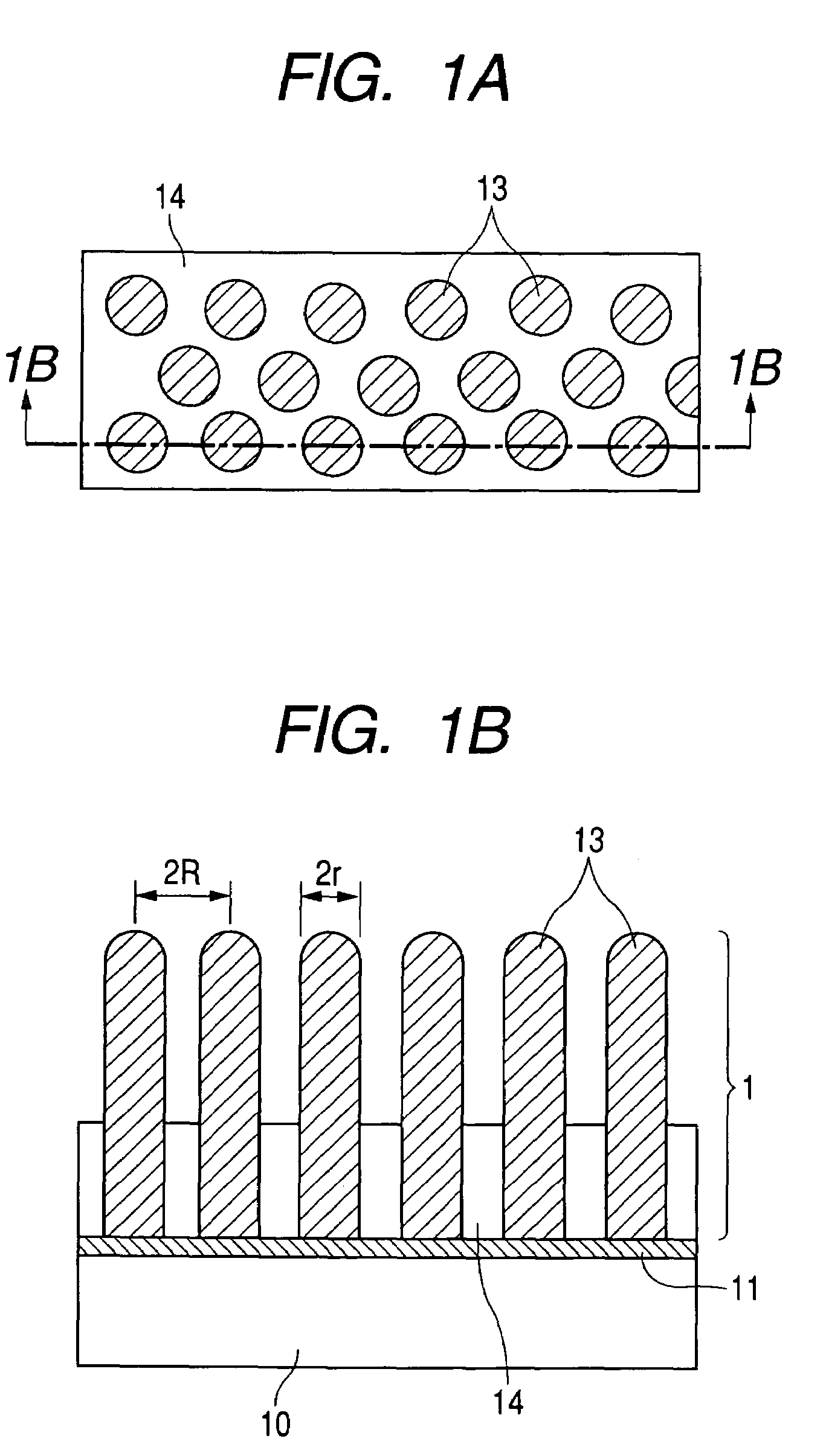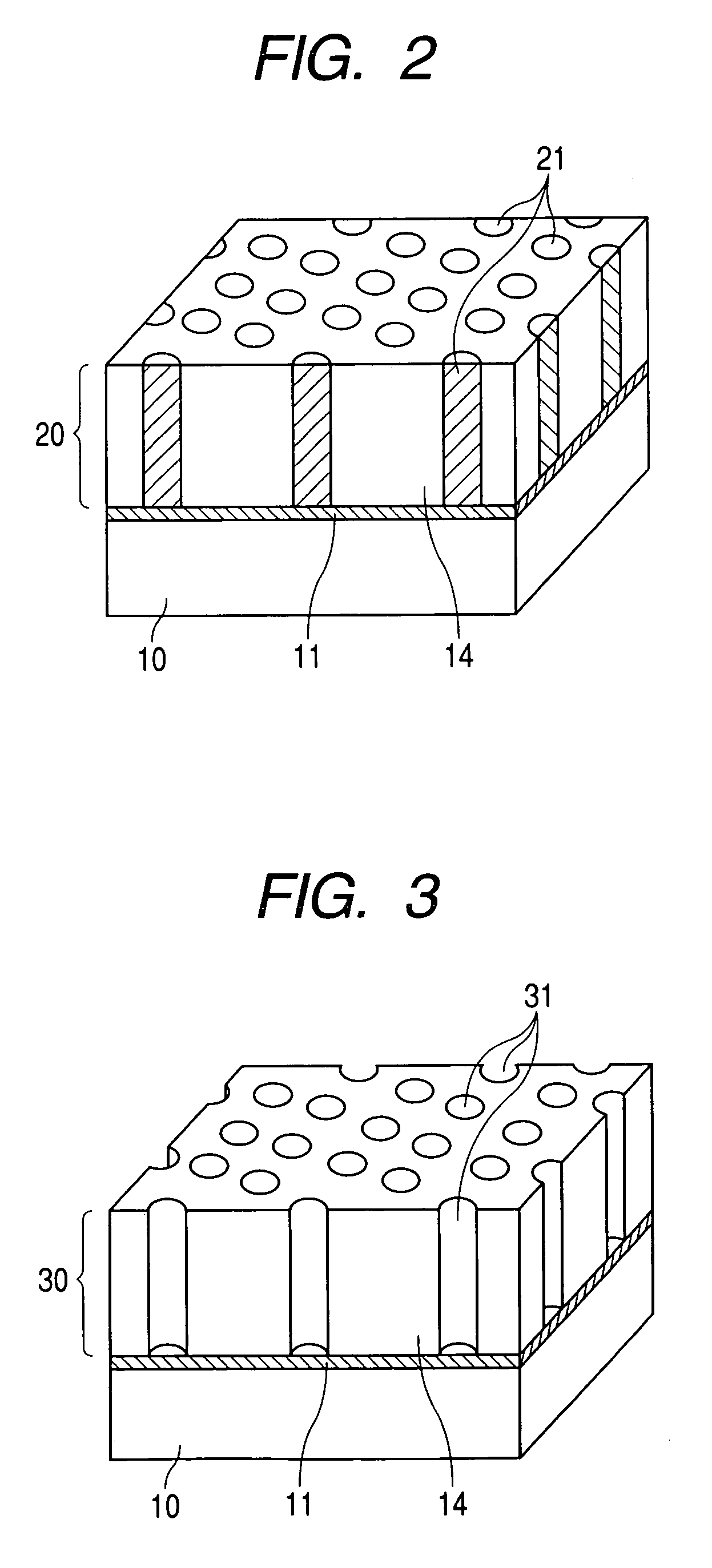Catalytic sensor structure
a sensor structure and catalytic technology, applied in the field of nanostructures, can solve the problems of increasing equipment costs, difficult to produce nanostructures with very small diameters and integrated at a high density, and poor yield of nanostructures by such semiconductor processing techniques
- Summary
- Abstract
- Description
- Claims
- Application Information
AI Technical Summary
Benefits of technology
Problems solved by technology
Method used
Image
Examples
example 1
[0132]FIGS. 5A, 5B, 5C, 5D, 5E and 5F are a flow chart showing one Example of a method for production of a nanostructure in the present invention as described previously. In this Example, one example of forming a nanostructure having Pt nanowires formed by the following steps (1) to (5) is shown.
[0133](1) Deposition Step 1 (Deposition of Underlayer) (See FIG. 5A)
[0134]As shown in FIG. 5A, a Si substrate 51 was used as a substrate, a Pd thin film 52 with the thickness of 20 nm was formed on the Si substrate 51 by the magnetron sputtering method in this step. The Pd thin film 52 is a catalysts layer for the electroless plating step described below.
[0135](2) Deposition Step 2 (Deposition of AlSi) (See FIG. 5B)
[0136]In this Example, an example of AlSi is shown, but the AlSi part may be replaced with AlGe or AlSiGe.
[0137]As shown in FIG. 5B, an AlSi structure thin film 53 with the thickness of 100 nm having AlSi as a main component was formed on the Pd thin film 52 with the thickness of ...
example 2
[0151]This Example shows one example of forming a nanostructure having Pt nanowires formed by the following steps (1) to (5).
[0152](1) Deposition Step 1 (Deposition of Underlayer), (2) Deposition Step 2 (Deposition of AlSi)
[0153]These steps are same as the steps in Example 1 described above.
[0154](3) Porous Member Forming Step Used by Electroless Plating Solution, (4) Step of Continuous Electroless Plating Steps
[0155]The thin film fabricated in the steps (1) and (2) described above was immersed in a platinum electroless plating solution at 60° C. for 1 hour. The Pt electroless plating solution used here is a plating solution prepared by mixing together 1) 100 mL of Rectroless Pt 100 base solution, 2) 10 mL of 2.8% aqueous ammonia, 3) 2 mL of Rectroless Pt 100 reducing agent and 4) 88 mL of pure water, and the pH of the plating solution is 12.
[0156]This sample was observed by a FE-SEM and as a result, it was found that Pt with the diameter of 5 nm and the height of 100 nm was filled ...
example 3
[0162]This Example shows one example of forming a nanostructure having Pt nanowires formed by the following steps (1) to (5). This Example shows an example in which Pd fine particles are used as a catalyst layer as a method different from the method in which “the Pd thin film fabricated by the magnetron sputtering method is used as a catalyst layer for electroless plating” described in the paragraph (1) Step of depositing Underlayer in Example 1.
[0163](1) Formation of Pd Fine Particles
[0164]A Si substrate was used as a substrate. Pd fine particles were formed on the Si substrate using a sensitive-active method that is generally known. First, the Si substrate was immersed in a SnCl2 solution to adsorb Sn2+ ions on the surface of the substrate. Then, The Si substrate was immersed in a PdCl2 solution, whereby Pd2+ ions were reduced according to the following reaction to deposit active catalyst nuclei on the surface of the substrate.
Sn2++Pd2+→Sn4++Pd
[0165]The following steps, i.e. (2) d...
PUM
| Property | Measurement | Unit |
|---|---|---|
| height | aaaaa | aaaaa |
| diameter | aaaaa | aaaaa |
| height | aaaaa | aaaaa |
Abstract
Description
Claims
Application Information
 Login to View More
Login to View More - R&D
- Intellectual Property
- Life Sciences
- Materials
- Tech Scout
- Unparalleled Data Quality
- Higher Quality Content
- 60% Fewer Hallucinations
Browse by: Latest US Patents, China's latest patents, Technical Efficacy Thesaurus, Application Domain, Technology Topic, Popular Technical Reports.
© 2025 PatSnap. All rights reserved.Legal|Privacy policy|Modern Slavery Act Transparency Statement|Sitemap|About US| Contact US: help@patsnap.com



